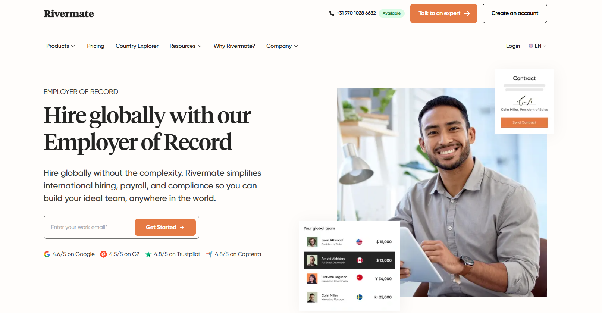
Global Workforce Management
Advantages of Hiring Independent Contractors vs Employees (2025 Edition)
Discover the top 10 benefits of hiring independent contractors and learn how they can save your company time and money.
Lucas Botzen
Global Employment Guides
17 mins read



Our Employer of Record (EOR) solution makes it easy to hire, pay, and manage global employees.
Book a demoTL;DR: Key take-aways on Employer of Record (EOR) costs
Hiring internationally comes with a steep learning curve, especially when it comes to compliance, payroll, and tax obligations. For companies expanding across borders, an employer of record (EOR) can simplify this complexity by becoming the legal employer of your international hires, managing everything from local contracts to statutory contributions.
But how much does an employer of record cost?
The short answer: it depends. Some providers charge as little as $199/month per employee, while others go north of $700 depending on the region and service tier. Understanding what’s included—and what’s not—is crucial to evaluating whether an EOR is cost-effective for your business.
In this guide, we’ll break down how EOR pricing works, what factors drive employer of record costs, and where hidden fees often lurk. We’ll also compare typical EOR models to the cost of setting up your own legal entity, and explain how a partner like Rivermate offers a transparent alternative built for compliance-conscious teams.
Let’s start by looking at how EORs structure their pricing.
EOR pricing typically falls into two main models: flat-fee pricing and percentage-of-payroll pricing. Each approach affects how predictable and scalable your hiring costs will be.
Many EORs offer a fixed monthly fee per employee. This fee usually ranges from $200 to $700/month per employee, depending on the provider, country, and service level.
Benefits of the flat-fee model:
Use case: A mid-sized company hiring 10 employees in different countries can model total spend upfront without variable spikes tied to salary or tax levels.
Some EORs calculate fees as a percentage of the employee’s gross compensation, typically ranging from 5% to 10%. For higher-paid employees or those in high-tax jurisdictions, this can become expensive quickly.
Challenges with the percentage model:
Example: For a gross monthly salary of $8,000, a 10% EOR fee would be $800—nearly three times more than a flat $299/month provider.
Some EORs combine both approaches depending on the country. For example, they may offer flat pricing in countries with stable regulatory frameworks but charge variable fees in markets with high compliance overhead (e.g., Brazil, China, France).
For example, local EOR firms typically offer lower pricing because they operate in one market and don’t carry the overhead of maintaining multi-country infrastructure. Smaller EOR providers may offer discounted rates for long-term commitments, particularly if you plan to scale your headcount over time.
While pricing models vary, most EOR fees cover a core set of services that make it possible to hire, pay, and manage employees in foreign markets without establishing a local entity.
Here’s what’s typically included in the monthly EOR fee:
Filing of social security, health insurance, pension, and other government-mandated contributions
Submission of employee-related reports to local authorities
Keep in mind: While these services are standard, not all providers include everything in the base fee. Some charge extra for add-ons like benefits setup, bonus payouts, or visa processing. We’ll cover that next.
On paper, an EOR’s monthly fee might look straightforward, but the actual bill can tell a different story. Many providers tack on hidden charges or offer à-la-carte services that inflate your total cost of employment. For example, G2 users of Rippling report that pricing transparency could be improved. Customers have flagged hidden fees, high setup costs, and unclear sales processes that make budgeting difficult.
Here are the most common extras to look for:
Some providers charge a one-time setup fee per employee. This may cover document processing, contract creation, and local registrations but not always transparently disclosed.
Expect additional charges if you terminate an employee, especially in countries with complex labor laws. Some providers apply:
While base salary processing is usually included, non-regular payments like bonuses or commissions might incur processing fees or require advance notice to be paid compliantly. For Deel, G2 users have reported that the fees can be relatively high depending on the withdrawal method.
If you’re invoicing in USD but paying employees in local currency, beware of foreign exchange spreads. Some providers mark up exchange rates, which adds up across multiple employees.
In high-complexity countries (e.g., Brazil, France, China), some EORs add a regional complexity premium, sometimes doubling your per-employee fee.
Platform limitations
Low-cost or software-first platforms may not offer:
A predictable, flat-fee partner avoids these pitfalls by bundling core services under one monthly price, with no setup or surprise add-ons. Now let’s look at what influences that pricing.
EOR costs can vary significantly depending on the country, the employee profile, and how much complexity is involved in maintaining compliance. Even among flat-fee providers, there are real differences in pricing tiers, and they’re not arbitrary.
Here are the key factors that drive employer of record costs:
Countries with high regulatory complexity or mandatory social contributions tend to have higher EOR fees. Examples include:
Some EORs (especially those using percentage-of-payroll pricing) will charge more for senior employees with higher compensation, bonuses, or stock grants. Even under flat-fee models, complex benefits or executive packages may require additional support and cost.
Statutory benefits are usually included, but supplemental benefits (e.g., private health insurance or retirement plans) and country-specific allowances (e.g., 13th-month pay, meal vouchers) can increase the total cost depending on how they’re structured or administered.
Highly regulated roles (e.g., in healthcare, finance, or government) may require more rigorous contract terms, local licensing verification, or legal oversight, leading to higher service fees.
The total number of employees can affect employer of record costs. Many providers use volume-based tiered pricing or give discounts for larger teams, while managing a single employee may attract higher per-head fees.
The range of services included—whether it’s basic payroll or more advanced support like legal guidance, visa processing, or HR tech integrations—can significantly impact pricing. Custom solutions and optional add-ons, such as bespoke reporting or white-glove support, often lead to price increases over time. This type of “pricing creep” is frequently noted in EOR provider breakdowns and third-party reviews.
Employer of Record costs aren’t a one-size-fits-all. Costs can vary depending on the EOR provider, local labor laws, required benefits, and the level of hands-on support offered. Regional complexity and economic conditions also influence fees.
Because of these variables, it’s always best to request a tailored quote to get accurate, up-to-date figures.
Below is a general range of monthly fees you can expect by region.
When evaluating employer of record costs, it’s not just about the monthly rate. It’s about what you get for that rate, and whether the pricing model supports your hiring goals. Here’s a breakdown of the pros and cons of the two most common models:
| Pros | Cons |
|---|---|
| Easy to budget and forecast | Flat-fee models may seem costly for junior roles. Deel users, for instance, have noted that pricing can be a challenge for smaller companies or startups, especially when hiring just a few employees. |
| Transparent pricing, minimal surprises | Add-ons may still apply with some providers. Rippling’s users mention the pricing can be higher than simpler HR tools, especially if you’re adding modules beyond core HR features. |
| Scales well across geographies and roles | Some providers charge a premium for high-touch support |
| Often includes dedicated account management. Example: Rivermate | Flat rate may not reflect local service variation |
Caption: Pros and cons of using a flat-fee pricing model for Employer of Record (EOR) services
Best for: Finance and HR teams that need clarity, predictability, and fast onboarding in multiple countries.
| Pros | Cons |
|---|---|
| Appears cheaper for low-salary employees | Costs scale with salaries, bonuses, and commissions |
| Pricing is directly tied to employee earnings | Less predictability for forecasting and budgeting |
| Useful when hiring in low-cost labor markets | Total cost of ownership is often higher long term |
Caption: Pros and cons of using a percentage-of-payroll model for Employer of Record (EOR) services
Best for: Companies hiring junior employees in a limited number of countries though rising salaries may erode savings quickly.

For mid-sized companies expanding internationally, predictable pricing plays a critical role in financial planning and managing operational complexity. Rivermate offers a flat-fee model designed to provide that clarity across all hiring markets.
Here’s how Rivermate simplifies and controls EOR costs:
Rivermate charges a transparent flat fee starting at €299/month per employee (approx. $350 per employee per month), regardless of country or employee salary. That means no upcharges in high-complexity regions, no surprise line items, and no commissions on compensation.
Included in the base fee:
What sets Rivermate apart is its focus on true partnership—something many platforms overlook. Instead of offering a one-size-fits-all service, Rivermate works as an extension of each client’s HR team, providing tailored, high-quality support for long-term, compliant growth.
This approach includes:
While other platforms force you into rigid workflows, Rivermate adapts to your operational needs. Whether you're hiring full-time engineers in Germany or relocating a team member to Canada, we can support custom contract terms, benefits structuring, and local guidance.
| 💡Case study: Hightekers expanded into five countries—Germany, Ireland, Belgium, Sweden, and Norway—without setting up entities. Rivermate’s EOR services enabled compliant hiring, added custom contract clauses, and managed local payroll and benefits, helping the company add 25 new employees while saving time and administrative effort. |
|---|
Selecting the right Employer of Record goes beyond monthly cost. The best-fit provider is one that matches your compliance needs, support expectations, and global hiring goals.
Use the following criteria to evaluate EOR providers before making a decision:
Users of Skuad, for example, revealed that the platform lacked transparency around benefits and social security costs, making it hard to verify charges. Ultimately, poor communication and billing mismanagement led to financial losses for the client.
| 💡 Look for providers like Rivermate that publish flat rates and offer real-time cost simulations. |
|---|
| 💡 Rivermate’s in-country legal teams update contracts automatically and provide alerts, backed by SLAs and indemnification. |
|---|
| 💡 Rivermate’s clients can reach their support team directly via Slack, WhatsApp, or email. No bots or waiting days for a reply. |
|---|
| 💡 Rivermate is designed for mid-sized companies hiring 10–15 employees per new country. Ideal for scaling global teams. |
|---|
Choosing the right partner can save you from costly missteps, from legal disputes to wasted time on inflexible tools. If global hiring is a strategic move for your company, the right EOR should feel like an extension of your HR, finance, and legal teams, not just a compliance tool.
Expanding globally comes with risk, especially if payroll, tax, or compliance slip through the cracks. The real cost of an EOR isn’t just the monthly fee. It’s about how well they manage complexity, support your team, and scale with your business.
With Rivermate, you get:
Book a 30-minute consultation with us to get a quote by country and see how a true EOR partner can support your global team.

Lucas Botzen is the founder of Rivermate, a global HR platform specializing in international payroll, compliance, and benefits management for remote companies. He previously co-founded and successfully exited Boloo, scaling it to over €2 million in annual revenue. Lucas is passionate about technology, automation, and remote work, advocating for innovative digital solutions that streamline global employment.


Our Employer of Record (EOR) solution makes it easy to hire, pay, and manage global employees.
Book a demo
Global Workforce Management
Discover the top 10 benefits of hiring independent contractors and learn how they can save your company time and money.
Lucas Botzen

Remote Work and Productivity
Discover the top benefits of hiring remote workers, from cost savings to productivity boosts. Learn why remote teams are the future of work.
Lucas Botzen

International Employment Laws
Discover the crucial role of the minimum wage in shaping the global economy and its impact on businesses and workers alike. From the highest rates in Luxembourg to the evolving economic landscapes in countries like Canada, understand why staying informed about these changes is essential for compliance and strategic business planning. Dive into the insightful analysis of the minimum wage's influence on employment trends, worker morale, and economic growth across various nations.
Lucas Botzen